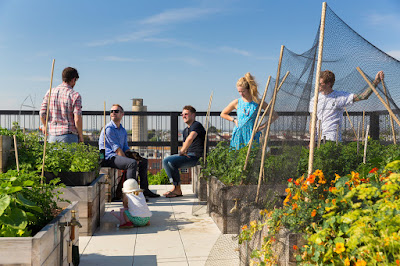Building a Shared Community
By Julia Bell
Co-housing is defined as an intentional community of private homes clustered
around shared space. Each attached or single family home has traditional
amenities, including a private kitchen. Shared spaces typically feature a
common house, which may include a large kitchen and dining area, laundry and
recreational spaces. Common characteristics are described below:
Relationships
Nightingale was developed on a similar ethos, guided by the notion of
affordability. The combination of an economical design, sustainability
and reduced developers profits makes the apartments more affordable whilst also
nurturing a social and community atmosphere within the development.
So could co-housing help us towards more affordable housing? Is it a way
of improving social inclusion? What ways could we incentivise co-housing
through the planning scheme?
 |
| Nightingale Housing |
Co-housing as a response to housing affordability – Building
a shared community
Melbourne’s median house price has broken the $700,000 barrier, with median rental prices also hitting $400 per week. The housing affordability crisis facing
Melburnians is made even more challenging by the lack of wage growth, with
growth hitting a record low of just 1.9 per cent over the past year.
It is becoming apparent that we must find more innovative ways to
respond to this housing crisis if we are to ensure Melbourne retains its ‘most
liveable’ title in the coming decades.
As the composition of our households continues to change, so too does
the housing typology needed. Our population is aging, and just over 30%
of households will be single person households by 2026. Social isolation is a
serious emerging issue. As lifestyles change, a new, sharing economy is
emerging, consisting of new, more collaborative paradigms of urban living.
Co-housing, though not a new initiative, is emerging more frequently in
medium-high density housing models as a way of entering the property market
which enables sharing of bills, cars and household goods, as well as trading
services like babysitting and care for the elderly.
Relationships
- Neighbours commit to being part of a community for everyone’s mutual benefit.
- Cohousing cultivates a culture of sharing and caring.
- Design features and neighbourhood size (typically 20-40 homes) promote frequent interaction and close relationships.
- Cohousing neighbourhoods are designed for privacy as well as community.
- Residents balance privacy and community by choosing their own level of engagement.
- Decision making is participatory and often based on consensus.
- Self-management empowers residents, builds community, and saves money.
- Cohousing communities support residents in actualizing shared values.
- Cohousing communities typically adopt green approaches to living.
Recent examples of co-housing at a high density include the Nightingale
and The Commons apartment developments in Brunswick. The Commons was developed
on the ideas of both achieving material reductionism and the positive social
impacts of share facilities. 15% of the property is devoted to communal
facilities, including a shared roof garden and laundry room. The communal
spaces encourage interaction with neighbours.
 |
A lower density version of co-housing that is also emerging is
single-dwelling suburban blocks being adapted to accommodate two or three
smaller dwellings with some share spaces, reducing the overall physical and
environmental footprint per household. It is similar in principle to
granny flat development but less restrictive, allowing more varied and flexible
household groupings.
Further Reading
http://theconversation.com/how-co-housing-could-make-homes-cheaper-and-greener-39235
http://theconversation.com/how-co-housing-could-make-homes-cheaper-and-greener-39235
https://www.theguardian.com/sustainable-business/2016/oct/31/the-commons-could-co-housing-offer-a-different-kind-of-great-australian-dream
http://nightingalehousing.org/the-commons-1/


Comments
Post a Comment